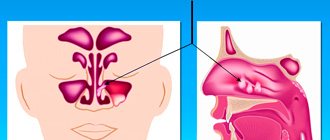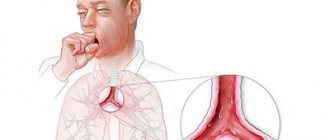Reasons why colds occur
Acute respiratory infections are a group of diseases that affect the respiratory tract.
The peak incidence of acute respiratory infections occurs in the autumn-winter season. This is due to the fact that the air temperature is lower at this time. Low temperatures contribute to the persistence of the pathogen in the environment. In addition, low temperatures often cause hypothermia, and this affects the immune system. As a result of hypothermia and infection, the disease develops. For the development of an infectious process, the existence of 3 components is necessary:
- Microorganism. It is the causative agent of the disease. It can be a bacterium, a virus, or less commonly a protozoan or a fungus. A typical representative of a viral infection is influenza, and a bacterial infection is sore throat. Pathogens have different virulence (ability to infect and cause disease). Their aggressiveness determines the likelihood of getting sick upon contact with a sick person and how severe the disease will be. There are more or less virulent strains of the same virus.
- Macroorganism. This is the human body in which the pathogen parasitizes, causing disease. The degree of susceptibility to infections depends on the state of the body and its immunity. The state of immunity is affected by nutrition, vitamins, background diseases, as well as various stresses. Stress for the body is not only psycho-emotional stress, but also hypothermia, overheating, lack of sleep, and many other factors.
- Environment. It affects both the infectious agent and the susceptible organism. For example, hypothermia, which reduces immunity, also refers to the effects of environmental factors. In addition, the microorganism is transmitted through the medium from a sick person to a healthy person.
From the above it follows that for the development of an infectious disease all 3 links are necessary. If, for example, there is a factor of hypothermia, but there is no contact with infection, then the disease will not develop. Although sometimes the pathogen is constantly present in the body and is activated when immunity decreases. According to this principle, for example, exacerbation of chronic tonsillitis occurs.
Causes of viral bronchitis
Common causes of bacterial bronchitis include:
- viral disease (mostly advanced form);
- weakening of the body's immune defense;
- hypothermia;
- prolonged stress;
- toxic poisoning;
- contaminated air;
- allergies;
- contact with a sick person.
The bacterial form of bronchitis occurs as a result of the proliferation of pathogenic microflora, namely:
- staphylococci;
- streptococci;
- pneumococci;
- Haemophilus influenzae;
- Moraxella;
- legionella;
- chlamydia;
- mycoplasma
These microorganisms can enter the human body with oxygen and blood, but if the immune system functions normally, then the development of the disease will not occur. When the body's defenses are weakened, bacteria begin to multiply rapidly. An inflammatory process begins that requires immediate treatment.
The development of bacterial bronchitis is preceded by a viral infection, that is, the disease can occur against the background of influenza, ARVI, or infection with adenoviruses. If the immune system cannot cope with the infection, or it is not treated correctly, then a complication occurs - bacterial bronchitis.
The causes of bacterial bronchitis, as a possible complication of a viral infection, are as follows:
- Exposure to physical factors - cold air, sudden temperature fluctuations, inhalation of dust and smoke, exposure to radiation, etc.;
- Exposure to the respiratory system of chemical factors - inhalation of air with its constituent pollutants;
- Presence of bad habits – smoking and alcoholism;
- Chronic infections in the mouth and nasal cavity;
- Allergic diseases, congenital disorders of the bronchopulmonary system;
- Decrease in the body's immune defense;
- Lack of adequate treatment.
Symptom difference
In order to understand the difference between a viral disease and a bacterial one, parents need to carefully monitor their child. The difference is noticeable already at the very initial stage.
Most viral diseases have an acute onset - the baby’s temperature rises to high levels (38.0-40.0 degrees), and he suddenly becomes ill. With the flu, the nose usually remains dry; with other acute respiratory viral infections, one of the first signs is liquid nasal mucus. This condition is described as “running from the nose.”
- Bacterial runny nose (rhinitis) differs in color, consistency and smell. Snot with such a runny nose has a thick consistency, green or dark yellow color, sometimes with blood streaks, and an unpleasant smell of pus. The onset of a bacterial disease is not acute or abrupt. Usually the temperature does not rise immediately, but gradually, however, it can gradually reach high values, but more often it is subfebrile and long-lasting, and the state of health also gradually worsens.
- With a viral infection, the general condition is disrupted literally from the first hours of illness. There are signs of intoxication, muscle and joint pain, severe headache, and sometimes nausea and vomiting against a background of high fever. With a bacterial disease, the area of discomfort is usually localized quite clearly. If the bacteria infect the throat, a sore throat is observed; if it gets into the eyes, it is conjunctivitis; if it is in the lungs, it is pneumonia. Bacteria can cause meningitis and severe bronchitis.
- The incubation period also varies. Viral infections develop in the body after infection in a few hours or a couple of days, and bacteria need about 10 days to two weeks to “get comfortable”, multiply in sufficient quantities and begin to secrete large amounts of toxins.
- Almost any viral “sore” goes away on its own in 3-6 days in the absence of complications. With bacterial ailments you will have to “tinker”; you usually cannot manage without a course (or even several courses) of antibiotics, and recovery is delayed.
- People often refer to the symptoms of ARVI, acute respiratory infections, influenza and bacterial rhinitis or sore throat with the single word “cold”. This is wrong. A cold is nothing more than a weakening of the child’s immunity, made possible as a result of hypothermia. A cold may well precede a viral or bacterial infection, but is not considered an independent disease. A cold can be distinguished from a virus or bacteria by the absence of fever and acute catarrhal symptoms.
You can learn more about how a viral infection differs from a bacterial infection from specialists below.
medical reviewer, psychosomatics specialist, mother of 4 children
Viral bronchitis: types, causes, symptoms
Dampness and cold indoors can become a factor in the development of viral bronchitis
Viral bronchitis, as the name implies, is an inflammatory process in the bronchi that began under the influence of viruses. About 200 such pathogens are known; the disease is often provoked by rotaviruses, influenza viruses, and respiratory sentential viral bodies. They settle on the mucous membrane of the nasopharynx, then move into the bronchi.
Viruses enter the body through the air, first of all affecting weakened people - the elderly and children. Unlike bacteria, viruses cannot remain inactive for a long time in the human body, so they quickly provoke inflammation. Factors that can weaken the body and make it vulnerable to viruses:
- dampness and cold in the room;
- crowding of people during the declared quarantine;
- difficult or impossible breathing through the nose;
- infection of the nasopharynx, resulting in the development of laryngitis, rhinitis, etc.
As it develops, viral bronchitis increasingly worsens a person’s condition. The main signs of the disease will be as follows:
- temperature rise to 38-39 degrees;
- muscle pain;
- cough and runny nose;
- a sore throat;
- lacrimation;
- loss of appetite;
- excessive sweating.
The main symptom of bronchitis is cough. It signals that inflammation is developing in the bronchi, as a result of which mucosal receptors provoke spasms (cough). Depending on the course of the disease, the cough will differ. At first it is a dry and tearing cough, after which breathing occurs with wheezing, and a coughing attack ends with the release of sputum. Clearing your throat is not easy. If the larynx is simultaneously affected, the cough sound will resemble the barking of a dog.
A feature of viral bronchitis is a short incubation period - this disease manifests itself 1-5 days after infection. As soon as the body produces antibodies to the pathogen, health will begin to improve. This will happen approximately 3-5 days from the onset of the disease.
Diagnosis of diseases
Laboratory testing is the main method for detecting bacterial disease in adult patients and children. For analysis, material containing bacteria is taken - sputum, scrapings, mucus, blood, urine. There are the following methods for microbiological diagnosis of infections caused by bacteria:
- Direct microscopy. The material taken for analysis is placed under glass and examined under a microscope. In this way, it is possible to quickly identify the origin of the disease.
- The cultural method is the inoculation of the pathogen on a nutrient medium and the cultivation of microorganisms for a certain time. The analysis requires a minimum of 48 hours, and weeks to detect tubercle bacilli.
- Linked immunosorbent assay. Aimed at determining the total amount of antigens and antibodies in the test material. A bacterial infection is detected very accurately in a blood test (shift in the leukocyte formula).
- Immunofluorescence reaction. To detect the presence of infection, pathogen antigens are associated with a specific antibody labeled with a fluorescent agent, with the microbe further identified by its glow.
- Polymerase chain reaction (PCR). In biological fluids taken for laboratory analysis, the amount of nucleic acids is determined and, based on the data obtained, a conclusion is made about infection.
Diagnosis of bacterial infections allows you to accurately determine the causative agent of the disease in order to prescribe effective treatment. Women who suspect a vaginal infection can conduct a preliminary test at home on their own (later a trip to the doctor is required). To do this, it is necessary to determine the deviation of the pH level from the norm.
- normal pH level is between 3.8-4.5;
- the test paper has a level between 1 and 14;
- if the color of the sample is outside the normal range, there is a vaginal infection.
The test only allows you to preliminarily determine the presence of harmful microbes in the microflora. More accurate and detailed testing is carried out in laboratory conditions. Self-medication is excluded, no matter what the home test is. If symptoms of infection are present, medications should be prescribed by a specialist. Features of bacterial infection are:
- The incubation period is long – it takes from two days to two weeks.
- There is often no prodromal period of the disease - it begins immediately, locally and pronouncedly.
- A general deterioration in health does not always accompany a bacterial disease, but is more often a sign of a respiratory viral disease.
- Another sign is how long the temperature lasts. Its value usually does not exceed 38 degrees, but the readings are constant.
- The blood picture with such an infection: increased level of leukocytes, increased number of neutrophils, high ESR, decreased content of lymphocytes.
By examining biological material, it is possible to accurately diagnose the cause of diseases, identify the causative microbe and identify methods of effective treatment, which is based on the use of antibiotics.
Differences between bacterial and viral bronchitis
Treatment of bacterial bronchitis comes down to prescribing antibacterial therapy.
For this purpose, patients are prescribed drugs from the following groups:
- Drugs from the group of cephalosporins. They do not have high toxicity, in particular, this applies to the third generation of these drugs. Their intake contributes to the destruction of the bacterial membrane and their subsequent death. Most often, doctors prescribe Ceftriaxone, Cefotaxime, Ceftazidime, Cefoperazone, Cefixime.
- Preparations from the group of macrolides, which have a bacteriostatic and bactericidal effect, make it impossible for bacterial flora to reproduce due to the production of a specific protein in their cells. Most often doctors prescribe: Azithromycin, Clarithromycin, Macropen, Sumamed.
- Drugs from the aminopenicillan group that have a detrimental effect on bacterial cells. These drugs include: Amoxiclav, Amoxicillin, Augmentin, Amosin.
- Drugs from the fluoroquinol group. They should be used with extreme caution as they have many side effects. These drugs include: Ofloxacin, Levofloxacin, Moxifloxacin.
Auxiliary drugs for the treatment of bacterial bronchitis are mucolytics and expectorants. This could be Ambrobene, Lazolvan, Ambroxol.
In addition, bronchodilators are prescribed to help eliminate bronchospasm. These drugs include: Berodual, Eufillin, Ventolin, Salbutamol.
If your body temperature rises, you will need to take antipyretic drugs, including: Ibuprofen, Paracetamol, Aspirin, etc.
It is useful to perform breathing exercises; during treatment, the patient is advised to drink plenty of fluids, physiological treatment and antihistamines are possible.
If the disease is severe, then hospitalization is indicated for the patient. In all other cases, it is necessary to adhere to semi-bed rest, avoid hypothermia and eliminate all irritating factors affecting the respiratory system.
As a rule, with proper selection of drugs, the disease can be quickly eliminated. Most often, it takes 7 to 10 days of taking antibacterial agents to achieve complete recovery. With an uncomplicated form of bacterial bronchitis, complete recovery occurs after two weeks.
Author of the article: Mochalov Pavel Alexandrovich | Doctor of Medical Sciences general practitioner
Education: Moscow Medical Institute named after. I. M. Sechenov, specialty - “General Medicine” in 1991, in 1993 “Occupational diseases”, in 1996 “Therapy”.
Other doctors
‹
Tick season has begun - how to protect yourself? Where to contact? First aid for a bite
Healthy recipe - ginger with lemon and honey: how to make ginger lemonade?
›
Treatment of bacterial bronchitis begins only after making and confirming the diagnosis. A course of antibacterial therapy is required. Antibiotics are selected individually. The course of therapy ranges from 5 to 10 days. In especially severe cases, injections are used instead of tablets, and the duration of treatment can be increased.
While taking antibiotics, it is advisable to take drugs that support intestinal microflora in order to avoid dysbacteriosis.
In addition to antibacterial drugs, antitussives are prescribed to help remove mucus from the bronchi. Doctors often prescribe the mucolytic and secretolytic drug Lazolvan to patients. The drug must be taken strictly in accordance with the instructions for use.
Anti-inflammatory and painkillers are often used. If there is a high temperature, it is brought down with antipyretic drugs.
Bed rest and plenty of fluid intake are recommended.
In some cases, you will need to take antispasmodics to eliminate bronchospasm.
At home, you can take decoctions of medicinal herbs that speed up the healing process by relieving inflammation. For bacterial bronchitis, mustard plasters on the feet are effective.
To strengthen the immune system, it would be useful to take immunomodulators and vitamin complexes. Additionally, read the publication about another effective method for complex therapy, “Treatment of bronchitis with compresses.”
Bronchitis of bacterial origin is an inflammatory process that affects the lower respiratory tract. In most cases, the disease is a complication that develops against the background of a viral infection. The mechanism of its development is as follows: if a person has a weak immune system, the bacteria that are present in the body of each of us are activated.
Bacterial bronchitis is caused by pathogenic bacterial flora, namely: streptococci, staphylococci, pneumococci, moraxella, legionella, chlamydia, mycoplasma.
Bacterial bronchitis is accompanied by characteristic symptoms. Its main feature is its sharp manifestation. The main signs of bacterial bronchitis are:
- Intoxication. It is signaled by a feeling of drowsiness and weakness, lethargy, and headache.
- Painful sensations. Pain or burning that the patient experiences in the area behind the sternum. This feeling is very debilitating.
- Cough. This is the third stage of the development of the disease, which occurs after the burning sensation.
In turn, the nature of the cough also changes at different stages of the disease. During the first days it is dry and hysterical, torments a person at night and does not allow him to sleep. Typically, this clinical picture lasts 3–4 days, after which the cough becomes wet and sputum begins to be produced. The sputum may have a mucous or mucopurulent consistency and have a greenish tint.
If there are no complications and the disease proceeds normally, after a few days the symptoms change. The patient has:
- an increase in body temperature up to 37.5 ° C, which is short-term;
- breathing becomes harsh;
- wheezing appears.
The nature of breathing can only be determined by a doctor by listening to the chest. Blood counts in this form of bronchitis remain normal.
In order to prevent the development of complications and chronicity of the process, it is important to correctly prescribe therapy for bacterial bronchitis. Antibiotics are the mainstay of treatment. But in addition to such medications, a complex of other medications is prescribed:
- antipyretics – to eliminate high temperatures;
- expectorants;
- bronchodilator drugs.
The success of treatment also lies in the use of injections, massages, inhalations, mustard plasters or cupping for bacterial bronchitis. In addition, complex therapy may include traditional medicine. Such recipes consist of the use of propolis and sage, lingonberries and mumiyo, horseradish and garlic. Already on the second day of complex therapy, a decrease in the intensity of symptoms is noted. The cough alone can bother patients for about one month.
Treatment methods for different types of bronchitis will be different. Let's look at them separately.
As for the treatment of the bacterial form of bronchitis, it can only be cured with the help of antibacterial agents. For each patient, medications are prescribed individually. Most often, for this purpose, the specialist prescribes Augmentin, Ceftriaxone, Azitrox, Sumamed.
Symptoms of an attack by pathogenic bacteria
All bacteria are classified into:
- non-pathogenic - do not harm humans;
- opportunistic - coexist peacefully with humans until a certain point;
- pathogenic – dangerous bacteria that cause serious diseases.
In addition, all types of pathogens have different virulence. This means that under equal living conditions, one type of bacteria will be more toxic to humans than another.
The release of toxins (poisons) into the body is the most important point in the development of infectious diseases. Bacteria can produce endotoxins. This occurs in the event of cell death and destruction (intestinal infection). The second option for intoxication of the body is the release of exotoxins during the life of a bacterial cell (diphtheria).
Depending on the location of the microorganisms, there are several types of bacterial infections, each of which manifests itself with different symptoms:
- Sexual infections in women. Some of the most common diseases are vaginosis, trichomoniasis, gardnerellosis, and yeast infection. Pathologies of the female genitourinary system as a result of changes in the vaginal microflora are manifested by the following symptoms: the formation of vaginal discharge of various characteristic colors and consistency, a burning sensation and itching, pain during urination, discomfort during sexual intercourse, a specific unpleasant odor. Female bacterial diseases can be provoked by douching, taking medications, changes in hormonal levels, decreased immunity, and frequent changes of sexual partners.
- Intestinal infection. It occurs as a result of the direct toxic effect of bacteria on the epithelium of the digestive tube and tissues of the gastrointestinal tract. Salmonellosis is characterized by increased body temperature, fever, abdominal pain, vomiting, and diarrhea. Staphylococcal intestinal infection occurs with a runny nose, sore throat, slight fever, loose stools, skin rashes, nausea, vomiting, and pain in the abdominal area. The general condition of the patient is similar to food poisoning. Typhoid intestinal infection - joints and throat hurt, loss of appetite, stomach pain. In severe cases - delirium, coma.
- Childhood diseases. The most common diseases are mumps, rubella, scarlet fever, measles, and tonsillitis. Toxins released by bacteria affect the child's internal organs. Symptoms of a childhood bacterial infection include: fever above 39°C, cough, general weakness, headaches, nausea, vomiting, plaque on the tongue and tonsils, skin rashes, severe intoxication of the body. To avoid complications, you must consult a doctor immediately. Children are almost always given antibiotics for a bacterial infection as treatment.
- Throat diseases. The following symptoms are characteristic of respiratory tract infection: deterioration in general health, a pronounced focus of the disease, purulent discharge, white plaque in the throat, low temperature at the initial stage of the disease. Often a bacterial throat infection is preceded by a cold. Bacteria can live in the body without showing themselves in any way, but after an acute respiratory viral infection, immunity decreases, and the rapid growth and reproduction of the pathogenic microbe begins. Effective treatment is impossible without taking antibiotics.
A decrease in immune defense is the main cause of many diseases caused by the fact that opportunistic microbes become pathogenic and very dangerous for the human body. Failure to promptly seek qualified medical help is fraught with serious consequences.
Differences between bacterial and viral bronchitis
The following symptoms of the disease characteristic of bacterial bronchitis are distinguished:
- general poor health, resulting from intoxication of the body;
- pain and burning in the throat;
- decreased appetite;
- lethargy;
- pain in the chest;
- increased body temperature;
- wheezing in the lungs when listening;
- hard breathing;
- sometimes there is shortness of breath;
- coughing.
At the initial stage, the cough is most often dry and painful. It appears during the day and also during sleep. After some time, the dry cough gives way to a wet one. In this case, the discharge of sputum is difficult.
In severe cases of the disease, the main symptoms include tachycardia, rapid breathing, increased white blood cells and increased ESR in the blood.
The duration of treatment depends on the form of the disease and the individual characteristics of the body. Additionally, read the article “Symptoms of purulent bronchitis.”
Characteristic symptoms will help to recognize bacterial bronchitis; moreover, at the beginning of the disease they are expressed too sharply. These signs include:
- lethargy and weakness of the body;
- pain and burning in the chest area;
- cough - at first it is dry and only bothers you during the day. As the disease progresses, sputum production appears, and coughing attacks can occur even at night. Even after all signs have been eliminated, coughing is often observed for a month;
- increase in body temperature;
- the appearance of impurities of pus or blood in the sputum;
- increased sweating;
- the occurrence of shortness of breath even with minor physical exertion.
With proper therapy, the recovery period is approximately ten days. Ignoring symptoms, prolonged progression of the disease and lack of competent treatment tactics can lead to pneumonia, bacterial pneumonia or death of the patient.
Since the development of bacterial bronchitis is always accompanied by a viral infection, the onset of the disease will be accompanied by the following symptoms:
- The appearance of a low chest cough;
- Nasal congestion, lacrimation;
- Increase in body temperature to moderate values (as a rule, the mark on the thermometer does not exceed 38.5 °C);
- The gradual transition of a dry cough into a wet one, which tends to intensify at night;
- The appearance of scanty, difficult to separate sputum.
Under the influence of a number of provoking factors, the disease can become bacterial.
In this case, symptoms of bacterial bronchitis appear:
- The body temperature rises to high values (the mark on the thermometer exceeds 38.5) and lasts for more than three days;
- The cough intensifies and torments the patient not only at night, but also during the day;
- Symptoms of purulent bronchitis are added, which are expressed in the appearance of shortness of breath and the separation of sputum with the inclusion of pus and blood;
- Sweating increases at night;
- Symptoms of general intoxication of the body with chills, headaches, weakness, photophobia and malaise increase;
- Shortness of breath appears even with slight physical exertion.
A long course of bacterial bronchitis can lead to bacterial pneumonia, pneumonia and death of the patient.
This form of the disease occurs with localization of infection directly in the lower regions of the respiratory tract. As a rule, it develops only after inflammatory viral diseases. The immune system is weakened by the infectious primary agent, then the secondary bacterial flora joins.
Microorganisms that provoke the development of this pathology are called cocci in the field of medicine. Among them are staphylococci, streptococci, and pneumococci. In addition, the disease is formed due to exposure to legionella and chlamydia. Legionella lives and also multiplies in air conditioner filters, especially if you ignore the prevention of this device.
The main symptoms of bacterial bronchitis are:
- Intoxication - drowsiness, weakness, headache, lethargy.
- Pain in the sternum area. The patient complains of an internal burning sensation, especially during coughing.
- Cough with sputum. In some cases, the amount is quite large.
Distinctive features
Bacteria and viruses are pathogens of infectious diseases that have many differences.
- Viruses can only reproduce in the human body. Bacteria divide freely under any favorable conditions. They are a full-fledged living organism that needs nutrition for development and self-reproduction.
- Bacteria are larger than viruses. They can be seen under a light microscope, and the largest ones can be seen with the naked eye. Viruses were discovered only after the invention of the electron microscope.
- The mechanism of action of viruses and bacteria is also different. The former cause symptoms of intoxication - fever, weakness, myalgia and arthralgia, and the latter - signs of local purulent inflammation - plaque on the tongue, plugs in the tonsils, accumulation of caseous masses in the lacunae.
- Infectious diseases differ not only in clinical symptoms, but also in the results of laboratory tests.
How to distinguish a viral infection from a bacterial one? These pathologies must be differentiated, since their treatment requires completely different drugs.
Signs that allow you to distinguish between diseases caused by bacteria and viruses:
- Duration of the course - symptoms of a viral pathology disappear within a week, while bacterial symptoms sometimes persist for more than a month.
- Viruses cause the production of colorless and liquid secretions. Bacteria stimulate the synthesis of cloudy yellowish or greenish thick mucus streaked with blood and purulent clots.
- Body temperature during bacterial diseases increases gradually and rarely reaches febrile values. Viruses cause a sharp rise in temperature to 39-40 degrees, which gradually decreases.
- Bacterial pathologies develop slowly and form a lesion in a certain area, which can be detected during a diagnostic examination. Microorganisms attack specific organs and systems. General deterioration of the condition occurs only in advanced cases. A viral infection manifests itself immediately and clearly, affecting the entire body without a clear localization of the process.
- The incubation period for bacterial infection lasts 1-2 weeks, and for a viral disease - several hours, maximum - a day. The prodromal period of a viral infection is pronounced and lasts a day; in a bacterial infection it goes unnoticed.
- Laboratory signs of viruses: leukopenia, lymphocytosis, monocytosis, bacteria - neutrophilia.
- Using microbiological examination of biomaterial from a patient, only the causative agent of a bacterial infection can be detected. To identify viruses, special laboratory conditions are required. They are cultivated in chicken embryos, cell cultures, and laboratory animals.
- Bacterial infections can only be cured with antibiotics. They will not help with ARVI. Antiviral drugs and immunomodulators are needed here.
Table of differences between viral and colds
In order to take the right measures when you first feel unwell, it is necessary to distinguish a viral infection from a bacterial cold in time. Each of these diseases has characteristic symptoms by which it can be recognized:
| Viral disease | Cold | |
| First signs | Appear suddenly | Gradually |
| Temperature | Above 38°C | Up to 37°C |
| Intoxication | Expressed as severe fatigue | No |
| Presence of rhinitis and congestion | In the first days | Straightaway |
| Sneezing | Appears immediately | Occurs after a runny nose occurs |
| Cough and chest pain | Severe cough accompanied by sore throat and chest | On the second day after hypothermia, discomfort in the throat and sore throat may occur. |
| Headache | If there are complications | No |
| Eye condition | Unpleasant sensations due to bacterial infection, secretion of tears | No discomfort |
| Insomnia | At high body temperature | No |
| General weakness | Eat. Caused by fever | Weak |
Where do they meet?
Bacteria: Bacteria live almost anywhere, including in/on other organisms and on inorganic surfaces. Some bacteria are considered extremophiles and can survive in extremely harsh environments, such as hydrothermal vents and the stomachs of animals or humans.
Viruses: Like bacteria, viruses can be found in almost any environment. They are capable of infecting animals and plants, as well as bacteria and archaea. Viruses that infect extremophiles such as archaea have genetic adaptations that allow them to withstand harsh environmental conditions. Viruses can survive (from a few seconds to several years) on surfaces or objects that we use every day.
How to tell if a disease is viral or bacterial
Let's look at the symptoms of viral and bacterial infections. You can understand whether a person has a viral or bacterial disease first of all by the symptoms. General malaise, fever and body aches, profuse lacrimation, sneezing, swelling of the nose and a clear runny nose, which go away on their own after 3-5 days, are usually signs of a viral disease. A viral infection is most often treated symptomatically, or with the help of antiviral or immunomodulatory drugs. The most common viral infections are: ARVI, influenza, measles, rubella, HIV infection, chicken pox, infectious mononucleosis, HPV, herpes virus, etc.
Plaque on the mucous membrane, pain in a certain place, high temperature, unpleasant odor, purulent discharge, daily deterioration of health in the absence of treatment most often indicate a disease of a bacterial nature. A bacterial infection can occur either on its own or as a complication after a viral illness due to weakened immunity. Basically, its symptoms begin with a local lesion (sore throat, nasal discharge, etc.). Diseases caused by bacteria are treated with antibiotics.
To avoid the formation of resistance, it is very important to be treated with a full course and preferably after conducting a sensitivity test (bacterial culture). The most common diseases caused by bacterial infections are: sore throat, sinusitis, bronchitis, otitis media, intestinal infections, cystitis, pyelonephritis, etc.
Treating viruses with antibiotics and bacteria with antivirals is fraught with complications. Because antibiotics do not kill viruses, treatment with them leads to an even greater decline in immunity, and antiviral drugs do not affect bacteria, which causes the disease to progress and can lead to serious consequences.
How to tell if bronchitis is bacterial or viral
At the initial stage of its development, the disease almost never occurs in bacterial form. The viral form of bronchitis begins with a high body temperature, runny nose, cough, and only then, in case of improper therapy or its absence, does the bacterial form of bronchitis occur. Thus, we can say that this will be a complication of viral bronchitis.
As a rule, the immune system to the virus is formed within 3-5 days. If by the 5th day of the disease the patient does not feel improvement, this indicates that bacteria are involved in the inflammatory process. In the case of bacterial bronchitis, the patient suffers from a very strong cough, with sputum being discharged. In this case, there will be no runny nose or inflammation of the eyes. The temperature lasts for quite a long time, about 5 days. However, it is no more than 37.5 degrees.
Treatment of bacterial diseases
A bacterial infection should only be treated by a highly qualified specialist. If symptoms appear, you must immediately visit your doctor or call an ambulance. Only after the tests can treatment be prescribed, which includes:
- Taking antibiotics. Medicines of local or general action are prescribed; they are able to neutralize the activity of microorganisms.
- Taking symptomatic medications that will help alleviate the child’s condition.
- Folk remedies are used to strengthen the body. They are taken with the permission of a doctor.
- Taking medications that restore beneficial intestinal microflora.
Immediately after the start of treatment, the child no longer poses a threat to others. This does not mean that they should be taken to prevent complications or stop the spread of infection among family members. If you start taking antiviral drugs very early, you can destroy beneficial microflora and allow bacteria to multiply even more.
Differences from viral colds
Viral and bacterial colds have many of the same manifestations, so it is difficult for an unprepared person to choose the right treatment. The erroneous use of antiviral drugs instead of antibiotics leads to an increase in the duration of treatment and sometimes worsening of the condition. But there are a number of signs that help to correctly establish the primary diagnosis.
- Duration.
- A viral disease does not last that long in terms of symptoms. A week is enough, a maximum of 10 days, and the cold is almost completely cured.
- With a bacterial cold, the time frame can be significantly delayed.
- Sputum/mucus format.
- In case of viral colds, the snot is glassy or whitish.
- When you have a bacterial cold, nasal discharge has a green, liquid consistency; the same picture is observed when you cough up sputum.
- Heat.
- With acute respiratory viral infections and influenza, a high temperature may bother you for 4-5 days, with a tendency to increase.
- With a common cold, this symptom lasts for several hours, a maximum of a day, then gradually returns to normal.
- Method of infection.
- Viral disease is not often transmitted by contact.
- Bacterial, transmitted by various means of distribution.
- Localization and development.
- The virus manifests itself immediately and intensely. The localization of the virus is the entire human body
- A bacterial cold is at first sluggish and unnoticeable. Affects one or more organs.
- Diagnosis and analysis.
- A developing viral infection does not affect blood counts in any way.
- Bacterial infection almost immediately increases neutrophil levels and monocyte counts.
What are the symptoms of a viral infection?
Viral infections of the respiratory tract occur with characteristic symptoms. The first symptoms of a viral infection are:
- malaise;
- headache;
- weakness and weakness;
- muscle pain.
At the next stage of the viral infection, patients first complain of scratching in the throat. Then it comes to severe pain, swelling and hyperemia of the mucous membrane, runny nose, sneezing, and nasal congestion appear. The tonsils are hyperemic and swollen.
Viral infection is most often transmitted by airborne droplets
A distinctive feature of a viral infection is a cough. At first it may be dry, then it becomes moist, with sputum discharge. General body temperature may be increased, but not very much (below 38°C).
Viral pharyngitis usually begins gradually and progresses in the same order. The duration of such an infection is about 7 days. But against the background of low immunity, it can last a little longer.
Signs of viral bronchitis
Viral cough in children appears quite often if the viral infection is acquired by airborne droplets from other patients or moves from already affected areas of the body due to rhinitis, pharyngitis, and sinusitis. To do this, at the first signs of illness caused by the virus, you need to consult a doctor. When conducting an examination, the doctor determines the viral etiology based on the following criteria:
- Severe coughing attacks with clear discharge;
- Shortness of breath appears, which is caused by coughing, and the patient cannot clear his throat completely;
- High temperature rises;
- The patient is shivering;
- When inhaling, wheezing is heard and discomfort appears in the chest;
- Obvious weakness and lethargy caused by the virus.
What infections are called bacterial?
Bacterial infections represent a huge group of diseases. They have one thing in common – bacteria. They are the most ancient and numerous microorganisms.
Based on the localization of bacterial infections, 4 areas can be distinguished:
- Airways;
- intestines;
- blood;
- skin covering.
Separately, bacterial infections in children and hidden sexually transmitted infections in women and men are distinguished.
Bacterial respiratory tract infections often develop after a cold, as a complication. The immune system becomes weaker, and pathogenic bacteria that previously did not manifest themselves in any way begin to multiply. Respiratory bacterial infections can be caused by the following pathogens:
- staphylococci;
- pneumococci;
- streptococci;
- whooping cough stick;
- meningococci;
- mycobacteria;
- mycoplasmas.
Infection of the upper respiratory tract usually manifests itself as bacterial sinusitis, pharyngitis and acute tonsillitis (more commonly known as tonsillitis). In this case, a pronounced focus of inflammation is always observed.
Bacterial infectious diseases of the lower respiratory tract include bacterial bronchitis and pneumonia.
Bacterial infections of the intestines often occur due to unwashed hands, consumption of poorly cooked, improperly stored or expired foods. In most cases the problem is caused by:
- shigella;
- staphylococci;
- cholera vibrios;
- typhoid bacillus;
- salmonellosis.
Bacterial intestinal infections are the most dangerous because their symptoms (such as diarrhea) are not always taken seriously.
Intestinal bacterial infections are most often manifested by the following diseases:
- salmonellosis;
- typhoid fever;
- dysentery.
In women and men, bacterial infections also affect the genitourinary system. Most often, women are exposed to bacterial vaginosis (gardnerellosis), chlamydia, cystitis, pyelonephritis, glomerulonephritis. Men suffer from urethritis, chlamydia, bacterial balanitis or prostatitis.
Children most often have viral infections, which are complicated by bacterial ones due to the weakening of the body during illness. In most cases, the following viral diseases are observed in childhood:
- measles;
- rubella;
- piggy;
- chicken pox.
Children who have had such infections receive strong immunity and are no longer exposed to these diseases. But if during the period of illness the child had contact with harmful bacteria, then it is quite possible for complications to develop in the form of bacterial pneumonia, otitis media, etc.
How to distinguish a viral infection from a bacterial one and their signs
How to distinguish a viral infection from a bacterial one and what are the signs of these diseases?
A viral infection is characterized by general damage to the body, while a bacterial infection most often acts locally. The incubation period for a viral infection is from 1 to 5 days, for a bacterial infection - from 2 to 12 days. A viral infection begins acutely with a rise in temperature to 39 °C or more. At this moment, there is general weakness and intoxication of the whole body.
The symptoms of a viral and bacterial infection have some differences. The bacterial infection begins gradually with more severe symptoms and a temperature of up to 38 ° C. Sometimes its appearance is preceded by a viral infection, in which case it is customary to talk about the “second wave” of the disease. Unlike bacterial ones, signs of a viral infection appear suddenly and more clearly.
What is the difference between a viral infection and a bacterial one, you need to know in order not to make a mistake with the choice of treatment. According to new guidelines from the Infectious Diseases Society of America, most throat infections are caused by viruses and should not be treated with antibiotics.
If antibiotics are used in the absence of appropriate indications, the formation of resistant bacteria is possible. Antibiotics also often cause side effects, including the development of disturbances in the quantitative and qualitative composition of the intestinal microflora. In addition, there is reliable data on an increased risk of bronchial asthma and atopic dermatitis in children who received antibiotics during preschool age.
Remember: bacterial infections are treated with antibiotics; Viral infections cannot be treated with antibiotics because these drugs do not work on them.
Bacteria are single-celled microorganisms without a cell nucleus that can live in almost any environment. They live in water, air, soil, penetrate host cells and are causative agents of bacterial infections in humans. The main places of localization of microorganisms are the respiratory tract, intestines and outer integument of a person. To effectively treat an infection, it is necessary to correctly diagnose what type of pathogenic bacteria caused the disease and choose effective ways to suppress the vital activity of microorganisms.
Differences between bacterial and viral bronchitis
We continue to consider how to determine whether a person has viral or bacterial bronchitis. First of all, it is necessary to understand whether the viral form of the disease occurs in practice at all. The answer will be yes. But how do you know if a patient has bacterial or viral bronchitis?
The bacterial form of bronchitis can be distinguished from the viral form by the longest incubation period, which takes from 2 days to 2 weeks. To identify the moment of infection, it is necessary to take into account not only the last contact with sick people, but also the recent state of excessive fatigue, hypothermia and nervous strain.
The majority of harmful microorganisms live in the patient’s body for months and years, without causing any discomfort. A sharp weakening of the immune system due to nervous shock or hypothermia causes the awakening and activity of these microbes. In addition, a bacterial infection tends to join a viral one.
Experts prefer not to waste time figuring out whether a given form of bronchitis is viral or bacterial. This is because the side effects of using antibiotics are much easier to eliminate than complications such as meningitis or pneumonia. Still, it will be simply useful to find out what kind of bronchitis, viral or bacterial. After all, with a viral form of the disease, antibacterial drugs are useless.
It is important to note that medications should only be selected by the attending physician, especially when it comes to antibiotics.
Main differences
The main difference between a viral disease and a bacterial one lies in the causative agent of the disease itself. Viral diseases are caused by viruses, bacterial diseases are caused by bacteria. With regard to childhood diseases, especially during the cold season, the most common are viral illnesses - influenza, ARVI. The famous pediatrician Evgeny Komarovsky claims that 95% of all cases of childhood morbidity with respiratory and general manifestations (runny nose, cough, fever) are exclusively of viral origin.
- Viruses cannot exist anywhere and anyhow; they are quite capricious in choosing their location. Typically, each viral infection has its own localization, its own site of replication of the causative virus. With influenza, the corresponding virus in the first stage affects exclusively the cells of the ciliated epithelium of the upper respiratory tract, with hepatitis - only liver cells, with rotavirus infection, the pathogen is activated exclusively in the small intestine.
- Bacteria are less fastidious. They begin to multiply where there is already a lesion. When a cut occurs, the wound begins to fester; when bacteria enter the larynx, if the integrity of the mucous membranes is damaged, severe purulent inflammation of the pharynx and larynx begins, for example, with bacterial sore throat. The bacterium can spread throughout the body, “settling” where local immunity is reduced.
- Often a bacterial infection is a complication of a viral one. If a child first fell ill with the flu, and a few days later, after a slight improvement, he became very ill again, it is possible that the immune system, greatly weakened by the fight against the virus, “overlooked” the activation of the pathogenic bacterium, and a bacterial complication began. The younger the child, the weaker his immune defense, the more likely complications of a viral infection may occur. Incorrect treatment also increases the chances of complications.
- When a virus infects a child, it always causes the production of specific antibodies in his body. Antibodies are also produced to bacteria, but they are not persistent. This is why children only get sick with some viral diseases once in their lives, for example, chickenpox. You can get sick with bacterial infections no matter how many times the infection occurs.
- Viruses and bacteria act differently in a child’s body, and differential diagnosis is based on this difference. The virus destroys the cell it infects; it cannot exist outside the cell. His task is to rebuild all the structures of the victim he has struck to suit his needs. The bacterium exists quite successfully outside the human body; it does not kill the cell, but merely parasitizes on it, poisoning the child’s body with the products of its vital activity - toxins. That is why, despite the superficial similarity, the symptoms of a viral disease differ from bacterial diseases.
Knowing the difference and being able to distinguish one from the other is necessary in order to correctly approach the care and treatment of a child. Viral diseases should never, under any circumstances, be treated with antibiotics. Antibacterial drugs are not effective against viruses and only increase the likelihood of developing severe complications.
Treatment of the viral form
The bacterial form of this disease is much less common than the viral form. Infectious lesions of the bronchi can be caused by exposure to the following types of bacteria:
- Haemophilus influenzae.
- Corynebacteria.
- Moraxella.
- Pneumococci.
- Meningococci.
- Chlamydia.
- Streptococci.
- Mycoplasma.
The vital activity of the above-described organisms causes significant disturbances in the functioning of the respiratory organs, for which reason it is necessary to begin treatment as soon as possible with antibacterial drugs, that is, antibiotics.
At the initial stage of its development, the disease almost never occurs in bacterial form. The viral form of bronchitis begins with a high body temperature, runny nose, cough, and only then, in case of improper therapy or its absence, does the bacterial form of bronchitis occur. Thus, we can say that this will be a complication of viral bronchitis.
As a rule, the immune system to the virus is formed within 3-5 days. If by the 5th day of the disease the patient does not feel improvement, this indicates that bacteria are involved in the inflammatory process. In the case of bacterial bronchitis, the patient suffers from a very strong cough, with sputum being discharged.
So, we continue to consider how bacterial bronchitis differs from viral bronchitis. The range of viruses that cause bronchitis includes about 2 thousand varieties. In most cases, these are influenza viruses, adenoviruses, respiratory syncytial viruses, coronaviruses, rhinoviruses, rotaviruses and many others.
Speaking about the differences between viral and bacterial bronchitis, you should pay attention to the fact that the viral form begins with a general deterioration in health, fever, loss of appetite, and muscle pain. The main symptom of bronchitis is the appearance of a cough. It appears due to irritation of the receptors of the bronchial mucosa due to the inflammatory process. The type of cough will depend on the specific causative agent of the disease, as well as the degree of organ damage.
In most cases, the disease begins with a dry paroxysmal cough, and then sputum is formed. Breathing after this becomes gurgling and wheezing.
If the disease affects not only the bronchi, but also the larynx, then a barking cough is observed. Initially, sputum is released in small quantities or is absent altogether. However, its quantity increases every day, and in the second week of the disease it may change color to greenish. The appearance of mucopurulent or purulent sputum is an alarming symptom that indicates the addition of a bacterial infection.
In the case of simple bronchitis, you can hear wheezing from the respiratory tract, it can be dry or wet. Character can change. The disease is usually not very severe. Within a few days, the temperature returns to normal, the symptoms of intoxication go away, and the swelling of the nasopharynx goes away.
It will take about 3 weeks for the phlegm to completely disappear, but a cough may occur during this time. In some cases, bronchitis can last for one month, due to the addition of a secondary infection.
The viral form of the disease does not pose any particular danger to the patient. However, the patient should be alert to complications of the main pathology. To minimize such complications, you must follow your doctor's recommendations. To do this, you should observe strict bed rest, ventilate the room, drink plenty of fluids, take antiviral drugs, mucolytics, vitamin complexes, as well as drugs that strengthen the immune system.
During therapy, it is necessary to adhere to fractional meals, the diet of which should be dominated by foods high in protein.
The described tips are relevant for all age categories of patients, but there are several features of drug treatment. Instead of antiviral medications, you can use extended-spectrum antibiotics, which have an increased effect on lung tissue. The course of therapy can also include expectorants and probiotics to restore the intestinal microflora.
Viral bronchitis is an acute inflammatory process that occurs in the upper respiratory tract. This form of the disease has a viral etiology, that is, the disease is caused by viruses. Viral bronchitis is a complication that occurs against the background of flu or respiratory diseases.
Characteristic symptoms allow this form of bronchitis to be distinguished from other diseases. So, the disease is accompanied by:
- very high body temperature;
- serious condition of the patient;
- moist cough;
- sputum separation;
- sputum has a thick consistency.
At the beginning of the development of the disease, the sputum is so thick that it is not rejected, making it very difficult for a person to cough up. But when drug treatment is used, aimed, among other things, at thinning the sputum, this process is facilitated and the sputum comes out more easily.
During the first 3 to 5 days, a person usually develops immunity against the causative virus. But if the disease cannot be overcome during this period, bacteria also become involved in the pathological process.
The mechanism of development of the disease is as follows: if a person has a weakened immune system, an infection can easily enter the body. It settles in the nasopharynx, but enters the bronchi with air. There, the viral infection begins to multiply, as a result of which the bronchial mucosa is damaged. Thus, the infection attacks the body’s defense system and penetrates even further.
Doctors point to a number of factors that can trigger the development of the disease:
- cold and damp weather or a room in which a person is constantly present;
- pathologies of nasal breathing;
- large gatherings of people, for example in a kindergarten or school;
- infectious processes occurring in the nasopharynx.
The bronchitis virus is transmitted by airborne droplets. This means that you can become infected even if a sick person sneezes on a person. Sneezing can release particles of saliva into the air, which can then be inhaled by a healthy person. Moreover, such a precaution as covering your mouth with a tissue when sneezing will not help.
There are a number of signs that can be used to distinguish one form of bronchitis from another. Here they are:
- By the nature of development. Bacterial bronchitis develops as a primary independent disease extremely rarely. Typically, viral bronchitis develops first, and with inadequate treatment it turns into a bacterial form.
- According to symptoms. Bacterial bronchitis is accompanied by a slight increase in temperature, while with viral bronchitis it increases significantly.
- For damage to the respiratory tract. Bacterial bronchitis affects the lower respiratory tract, while viral bronchitis affects the upper.
- According to the severity of the leak. As a rule, viral bronchitis is much more severe than bacterial bronchitis. At the same time, it is worth remembering that it is the viral form of bronchitis that can cause complications in the form of a bacterial form.
- According to the nature of the sputum. With bacterial bronchitis, it has a mucous consistency, and with viral bronchitis, it is thick and difficult to reject.
However, to accurately determine the form of bronchitis, it is necessary to undergo a series of laboratory tests.
Difference between viral and bacterial infectious diseases
The problem of differentiating viral and bacterial infections is extremely relevant today. And it is extremely difficult for a doctor in a clinic, who is allotted only 12 minutes to communicate with a patient, to do this in the allotted time. For this, various diagnostic methods are used:
- Bacterial diseases are accompanied by high fever and the presence of purulent discharge (from the nose, on the surface of the tonsils, with sputum).
- Bacterial diseases are characterized by the absence of positive dynamics on days 5-7 (which most often occurs with viral infections) and a second wave of deterioration after a period of improvement (with the exception of adenoviruses).
- Blood test: viral infections are characterized by an increase in the number of lymphocytes, and bacterial infections - neutrophils. In both cases, the level of leukocytes and ESR increases.
- Express test for streptococcus and influenza virus (not carried out everywhere).
- Microscopic examination of nasal discharge, throat swab, sputum analysis.
- Other tests: procalcitonin, C-reactive protein, study of protein fractions. They are expensive and are used as a last resort.
The difference between infections caused by bacteria and viral infections is that the main aspect of their treatment is antibiotics. Western experts give a certain percentage of patients (20-30%) for whom self-healing from bacterial diseases is possible, because the human immune system is very strong and can even fight them. However, the lack of antimicrobial treatment in this case is fraught with serious complications, including such serious illnesses as pneumonia, meningitis, endocarditis and sepsis. Therefore, if effective antibiotics are available, the risk caused by not treating (hoping to hit that 20-30% of people) is not justifiably high.
Timely consultation with a doctor in case of a cold infection significantly reduces the risk of complications. You should not self-medicate, even with a banal ARVI.
There are several ways of transmitting viral and bacterial infections, some of them are similar (for example, contact), but there are also differences. The most important thing is why viral and bacterial diseases should not be confused - these are different methods of treatment. If antibiotic therapy is prescribed for bacterial infections, then treating viral infections with antibiotics is useless.
Differences in treatment
Viral and bacterial infections in adults must be treated. Depending on the severity of the disease, therapy takes place at home (mild to moderate) or inpatient (moderate to severe). The body needs to be rid of toxins.
ATTENTION! An adult patient on his own should take at least 1.5-2 liters of water per day (if it is not infectious myocarditis or endocarditis).
Viral and bacterial infections in adults differ in their approach to treatment:
- In most cases, there is no etiological treatment for a viral infection, since the pathogen is located inside a cell of the human body. The human immune system copes independently, the main thing is not to disturb it, only to cleanse the body of toxins in a timely manner and supply it with nutrients.
- For a bacterial infection, it is important to prescribe the correct etiotropic treatment (direct effect on the pathogen). This is done with the help of antibacterial drugs or antibiotics. They do not affect viruses.
- A viral infection can be treated symptomatically. Treatment with antiviral and immunomodulatory drugs is most effective in the first 2 days of the disease.
- Bacterial disease must be treated at all stages. There is little symptomatic therapy; antibiotics are required. Immunomodulating or immunostimulating drugs are not needed in treatment; they can be taken for preventive purposes after treatment.
The duration of a bacterial infection is longer than a viral one, so therapy is necessary until the symptoms disappear completely, and sometimes until the laboratory values are completely clear (even if the symptoms have disappeared).
Viral infection differs in that symptomatic treatment is carried out until the symptoms disappear. There are no clear indications when it should be completed.
Manifestations of viral and bacterial infections
- The acute onset of the disease, usually with a rise in temperature to 38 degrees, is a sign of the body's immune reaction, accompanied by other symptoms, depending on the type of virus. Thus, acute respiratory infections and influenza almost always manifest themselves as a runny nose and cough; with most so-called “children’s” infections, a characteristic symptom is a rash - chickenpox, rubella, scarlet fever. Viral mumps or mumps - inflammation of the lymph nodes, etc. A characteristic sign of a viral infection may be a headache, which is felt in the forehead.
- Viruses that affect the gastrointestinal tract (rotavirus, adenovirus, norovirus) cause nausea, vomiting, intestinal upset and, as a rule, an increase in temperature up to 38 degrees.
- Diseases caused by bacteria are most often severe, and the temperature can rise to very high levels. A bacterial infection can develop as a complication after a viral infection, or when harmful bacteria penetrate from the outside. The methods of transmission of bacteria are very diverse - from airborne droplets to contact and oral-fecal. Unlike a viral infection, which affects the entire body, most bacterial ones have a specific localization - the membranes of the brain (meningitis), the upper respiratory tract (sore throat), the gastrointestinal tract, the lungs (pneumonia) and others.
- Elevated body temperature during a viral infection decreases on days 3-5, and during a bacterial infection it can rise until the start of treatment.
- With a bacterial infection, the skin is pale, even at high body temperature.
Characteristics of bronchitis of viral origin
Bronchitis of viral origin
Viral bronchitis is a disease caused by a virus that causes inflammation in the areola of the bronchi. The list of viruses that provoke its development contains about two hundred varieties. The most common of them:
- influenza viruses;
- rotaviruses;
- respiratory-sentient viruses.
First, when they enter the nasopharynx, they settle and then move freely into the bronchi.
The disease is transmitted by airborne droplets, so when patients sneeze and cough, they become a source of infection for healthy people. The disease primarily affects children, since their bodies are more susceptible to infection.
The nature of viruses is such that, unlike bacteria, they cannot remain in the human respiratory tract for a long time without exposure. After the infection has entered the body, it causes an inflammatory process.
The disease often begins its development due to such provoking factors:
- cold and increased dampness of the room in which a person is present;
- gathering of a large number of children or people during quarantine;
- inability to breathe through the nose;
- the nasopharynx is affected by infectious processes (rhinitis, laryngitis, pharyngitis).
At the beginning of its development, this disease provokes a deterioration in the general condition of the human body:
- Increase in body temperature to 38-39 degrees.
- Painful sensations in the muscles.
- Cough.
- A sore throat.
- Runny nose.
- Watery eyes.
- Lack of appetite.
- Profuse sweating.
Cough is the main symptom of this disease. Its occurrence occurs through an inflammatory process in the bronchi, which irritates the receptors of the mucous membrane of the organ. The nature of the cough depends on the type of infection and the degree of damage to the bronchial walls. Usually, a dry cough appears first, and then thick sputum forms, and wheezing is heard when breathing. It is difficult for a person to clear his throat. If the larynx is also affected along with the bronchi, a barking cough occurs.
The peculiarity of bronchitis of viral origin is a short incubation period (1-5 days). When a person develops antibodies to the virus that causes the disease, his health improves. Usually 3-5 days pass after the onset of the disease.











